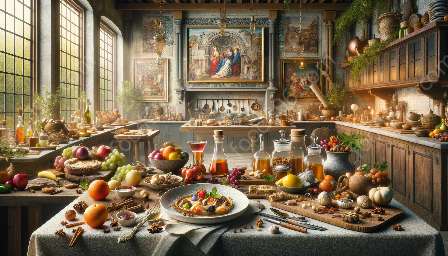Step into the enchanting world of Renaissance banquets and feasts, where lavish feasting, artistic presentation, and social customs defined a culinary era that continues to captivate us today. In this article, we will delve into the intricate tapestry of Renaissance culinary history, exploring the significance of banquets and feasts and their place in the broader context of cuisine history.
Renaissance Cuisine History
The Renaissance period, spanning from the 14th to the 17th century, witnessed a remarkable transformation in the culinary landscape of Europe. Renaissance cuisine was characterized by a fusion of flavors, innovative cooking techniques, and an emphasis on opulence and artistry in food presentation.
During the Renaissance, culinary traditions were shaped by a confluence of cultural influences, including the revival of ancient Roman and Greek culinary practices, trade connections with the East, and the emergence of new ingredients from the age of exploration.
Renaissance Banquets and Feasts
Renaissance banquets and feasts occupied a central place in the social and cultural fabric of the era. These grand gastronomic events were not merely about indulging in elaborate meals, but also served as platforms for displaying wealth, power, and artistic creativity.
The Art of Banqueting
The term 'banquet' in the Renaissance context referred to a sumptuous and elaborate meal that was often served in multiple courses, each carefully choreographed to create a sensory experience for the diners. A key feature of Renaissance banquets was the concept of 'subtleties,' which encompassed intricate edible sculptures, confections, and displays that showcased the culinary and artistic skills of the hosts.
The Feast of the Senses
Feasts during the Renaissance were not just about satiating hunger; they were immersive experiences that engaged all the senses. From the visual splendor of table settings and decorations to the aroma of exotic spices and the melodious accompaniment of musicians, Renaissance feasts were designed to elevate the act of dining into a multi-sensory spectacle.
Social and Symbolic Significance
Partaking in a banquet or feast was a social affair imbued with layers of meaning and symbolism. The seating arrangements, the choice of dishes, and the manner of serving all carried social cues and hierarchical distinctions that reflected the power dynamics and etiquette of the day.
Cuisine History: A Tapestry of Culinary Evolution
As we trace the evolution of cuisine history, it becomes evident that Renaissance banquets and feasts were pivotal in shaping the culinary landscape of subsequent eras. The innovations in food preparation, the fusion of flavors, and the emphasis on culinary artistry during the Renaissance continue to influence modern culinary practices.
The legacy of Renaissance banquets and feasts lives on in our culinary traditions, reminding us of the enduring fascination with gastronomic opulence and the art of dining.
From the opulent banquets of Renaissance Europe to the modern-day culinary extravaganzas, the thread of history weaves a rich tapestry of flavors, traditions, and social customs that continue to define our relationship with food and dining.

